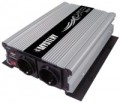Rated power output
The total power supplied by the autoinverter in normal operation. In other words, this parameter can be described as the
highest rated power of the connected load, at which the device is able to work without failures and overloads for a long time (comparable to the discharge time of the battery used for power).
Accordingly, when choosing according to the rated output power, it is worth proceeding from the energy consumption of the intended load. At the same time, it is worth choosing an inverter with a margin of 15-20% — for example, for a laptop with a consumption of 150 W, a device with at least 175 W is recommended. This is due not only to overload protection, but also to the fact that many inverters are able to deliver the claimed power only when the battery is fully charged, and as this charge is exhausted, it decreases.
It is also worth considering that some devices, such as car refrigerators or household vacuum cleaners, consume significantly more energy when starting up than during normal operation. Therefore, when choosing an inverter for such devices, it is worth focus not only on the rated, but also on the peak power — the power that the auto-inverter is capable of delivering without consequences within a few seconds.
Peak power output
The highest total power supply (peak) that the autoinverter can deliver to the load for a relatively short time is 2-3 s. Usually, this power is higher than the nominal one (see above) by 30-50%. At the same time, if you choose an inverter for maximum power, the same rules apply as for the nominal one — the device performance should be 15-20% higher than the total power of the connected load. And to work with devices that consume a large amount of energy at startup (vacuum cleaners, power tools, etc.), it is also worth specifying the peak power of the inverter — it should not be lower than the "starting" load power.
Efficiency
Efficiency of the autoinverter.
Efficiency is the ratio (in percent) between the amount of energy that the device delivers to the load and the amount that it consumes from the vehicle's on-board network. Accordingly, the higher this indicator, the more efficient the work and the less loss during conversion. In fact, this means that, other things being equal, a device with a higher efficiency will allow the load to run longer on battery power; this is especially important at high power consumption.
In modern auto inverters, efficiency values of 80 – 85% are considered average, 90% or more are good.
Number of sockets
The number of standard sockets for 230 V provided in the design of the auto-inverter.
The more outlets, the more electrical appliances can be connected to the inverter at the same time. At the same time, the specifics of using automotive converters is such that they rarely have to be used for several devices at once. In addition, simultaneous connection requires appropriate power (see "Rated output power"), and the sockets themselves also significantly affect the dimensions. Therefore, most often in modern models
one outlet is used — this, usually, is enough. However, high-end powerful inverters can have
two outlets.
Low battery alarm
The presence in the auto inverter
of the low battery alert function to which the device is connected.
This function significantly reduces the risk of “landing” the car battery through the use of an inverter and at the same time eliminates the need to manually monitor the battery status. The alarm, usually, reacts to the voltage at the input: with a significant decrease, indicating a deep discharge, the device gives a warning signal. Many models also have the function of automatic shutdown some time after the alert is triggered (by timer or when the voltage drops to the maximum allowable). The sensitivity threshold is usually adjusted in such a way that after the alarm is triggered and the inverter is turned off, the battery is still able to start the car engine.
Remote control connection (RJ-45)
The presence of
an RJ-45 connector allows you to connect a wired remote control to the inverter. Using a cable with RJ-45 connectors at both ends, the auto-inverter is connected to the remote control for remotely turning on/off the device, setting parameters, monitoring system status, etc. It is worth noting that the remote control is not always included in the kit; you will often need to purchase it separately.
Operating temperature
The range of ambient air temperatures in which the car inverter is guaranteed to maintain normal performance. It is necessary to focus here on the expected minimums and maximums
of operating temperatures. For example, if in a harsh winter the thermometer readings do not fall below -15 ° C, then the devices from the “-20 ° C and below” item for such operating conditions will be enough with a margin.
Dimensions
General dimensions of the autoinverter.
In modern cars (especially passenger cars), usually, there is not much space for installing additional equipment. This parameter allows you to estimate the space required to place the inverter, make sure that the selected device fits into the “footprint”, and, if necessary, choose another location or another model. At the same time, it must be remembered that for many auto-inverters a certain margin is needed in place — for the normal operation of the cooling system; this margin is usually specified in the detailed documentation.

